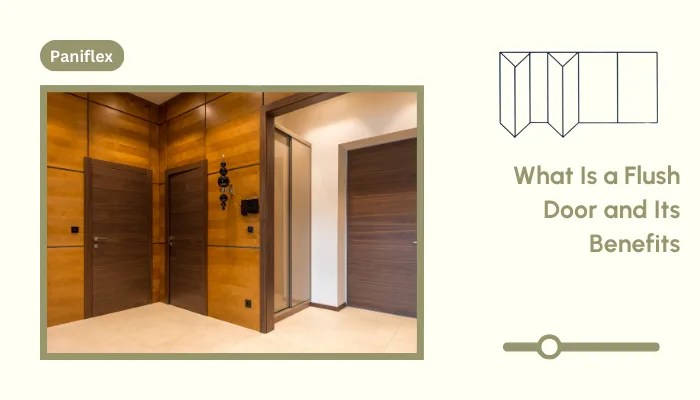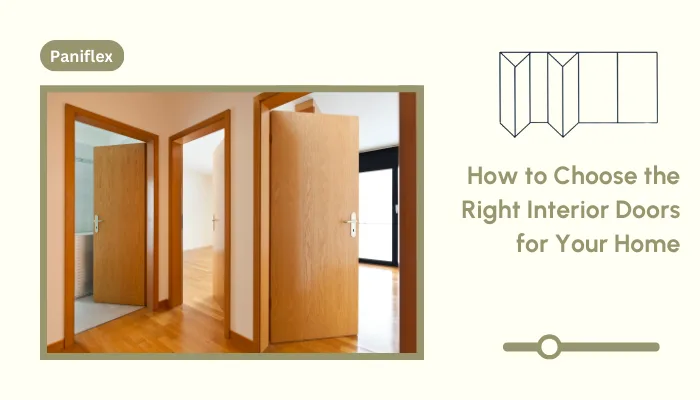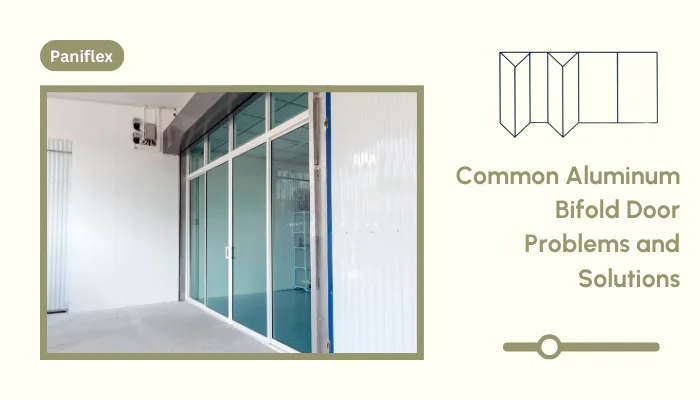Bifold doors are an excellent solution for residential and commercial areas. They combine functionality with style. These doors provide the perfect solution for upgrading a closet, creating a partition, or adding a modern feature.
However, understanding the time and process of installing bifold doors is crucial to achieving a smooth, professional result.
Installation can vary depending on factors such as the size of the door and the surface it’s being installed on. This guide will break down the typical timeline and process for installing bifold doors, ensuring you are well-prepared for a seamless setup that allows your doors to function perfectly and last for years.
Ready to experience the benefits of custom closet doors? Explore our range of Paniflex products now.
Factors Affecting Installation Time
Installing bifold doors may seem like a quick job, but several factors can affect how long it takes. From the size of the doors to the type of floor you are working with, each element determines the time required to complete the installation.
Understanding these factors can help you plan accordingly and set realistic expectations for the installation process.
Door Size and Type
The size and type of bifold doors can significantly impact installation time. Larger doors, custom designs, or heavier materials often require more time for both measurement and installation. Additionally, some doors may need special handling or custom adjustments, which can add extra steps to the process.
Larger or custom-sized doors may require additional cutting, reinforcement, or adjustments to ensure proper fitting and smooth operation.
Tips for faster installation: Ensure you have accurate measurements ahead of time to avoid delays during installation. If you are opting for custom doors, check with the manufacturer for any specific instructions that could streamline the process.
Floor Type
The surface on which you install the bifold doors significantly affects the time it will take. Concrete, wood, and tile floors all require different approaches. For example, concrete floors may need specialized anchors and pre-drilling, which can extend the time needed for the installation.
Concrete and tile floors often require more work, such as drilling and securing anchors, whereas wood floors may allow for easier installation of screws or tracks.
Tips for faster installation: If you are working on concrete or tile, make sure to have the right drill bits and anchors before you start to avoid delays during installation.
Tools and Equipment
The right tools make a significant difference in how quickly and smoothly you can complete an installation. Having the proper drills, screws, levels, and track systems ready to go will save time and reduce frustration. If you need to rent or purchase tools, factor this into your time estimate.
Missing tools or using the wrong equipment can slow down the installation process or require multiple trips to the hardware store.
Tips for faster installation: Double-check that all necessary tools are on hand before beginning the project. Investing in quality tools can help improve both speed and precision during installation.
Existing Space Conditions
The condition of the door frame and surrounding area affects the length of the installation. If the space is well-prepared, installation can be completed more quickly. However, uneven walls, frames that need adjustment, or outdated hardware can add extra steps to the process.
Preexisting issues, such as an uneven floor or door frame, may require additional leveling or adjustment to ensure the bifold doors hang properly.
Tips for faster installation: Inspect the space thoroughly before starting. Additionally, adjust the door frame or floor as needed to ensure a smooth installation process.
Understanding these factors can help you better plan your installation timeline and avoid unnecessary delays. Being prepared with the right tools, equipment, and knowledge will ensure that the installation process is as smooth and efficient as possible.
Recommended Watch: This video provides a step-by-step guide on installing bifold doors.
Now that we better understand the factors affecting installation time, we can examine the step-by-step process of installing bifold doors.
Step-by-Step Installation Process
Installing bifold doors may seem intimidating at first, but breaking the process down into clear, manageable steps ensures a smooth and successful installation. Following these steps carefully ensures that your doors are properly fitted, aligned, and ready for years of reliable use.
Let us go through each phase of the process, from preparation to the final adjustments, to help you achieve the best possible results.
1. Preparing the Opening
Before you begin installing the bifold doors, it is crucial to ensure the door frame and surrounding area are properly prepared. An uneven or improperly sized opening can lead to problems with alignment, movement, and the doors’ overall function.
Steps:
- Measure the door frame: Accurately measure the door frame’s height, width, and depth to ensure the bifold doors will fit perfectly.
- Check for level: Use a level to check if the frame is straight. If the frame is uneven, you may need to make adjustments before proceeding with the installation.
- Clear the area: Make sure the space around the door frame is free from obstructions to give you room to work.
From the Community: This Reddit discussionoffers helpful insights on measuring and framing the rough opening for bifold doors.
2. Installing the Track
Once the opening is ready, the track must be installed. The track system is critical for guiding the bifold doors as they fold and slide, so it must be securely fastened and leveled.
Steps:
- Mark the track placement: Using your measurements, mark the locations where the track will be mounted on both the floor and the wall.
- Pre-drill holes: Pre-drill holes in both the wall and the floor for the track anchors. Use the right drill bit to avoid damaging the wall or floor.
- Install the floor track: Attach the floor track to the pre-drilled holes. Ensure it is level and secure, as this will support the weight of the doors.
- Install the wall track: Position and install the wall track. Make sure it is aligned with the floor track. If you are not drilling into studs, use wall anchors.
3. Hanging the Doors
After the track is securely in place, it is time to hang the bifold doors. Properly aligning the doors with the track is essential for smooth operation and to prevent binding or misalignment.
Steps:
- Align the hinges: Position the door panels and align the top and bottom hinges with the corresponding track slots.
- Attach the doors to the track: Secure the doors by attaching them to the track system using the provided screws. Make sure the doors slide freely without resistance.
- Check door placement: Verify that the doors are positioned correctly and can move smoothly across the track.
4. Adjusting the Doors
At this stage, adjustments may be necessary to ensure the doors are properly aligned and function smoothly.
Steps:
- Adjust the height: Use a wrench or screwdriver to adjust the height of the doors to ensure they hang evenly in the frame.
- Check door alignment: Open and close the doors to ensure they fold and slide smoothly. If they resist opening or closing, adjust the hinges or track.
- Fine-tune door movement: If the doors are not closing properly, loosen the screws slightly and adjust the alignment until the doors close smoothly and are flush with the door frame.
5. Final Checks and Cleaning
After the doors are installed, it is important to do a final inspection to ensure everything is in working order. This step also includes cleaning the area and making any necessary finishing touches.
Steps:
- Test the door movement: Open and close the doors multiple times to ensure they operate smoothly. Check for sticking or uneven movement.
- Make final adjustments: If needed, adjust the hinges or track again to eliminate any binding or friction.
- Clean the installation area: Remove any dust or debris from the installation process. Wipe down the doors and track to ensure a clean finish.
Following these steps will ensure that you successfully install bifold doors that are aligned, functional, and aesthetically pleasing. Each step, from preparing the opening to the final cleaning, ensures that your doors will operate smoothly and last for years.
If you are looking for high-quality bifold doors and hardware, Custom Door & Mirror offers expert solutions that are easy to install and durable.
The next section will discuss the key best practices to follow when installing bifold doors, ensuring a streamlined and effective installation process.
Best Practices for Bifold Door Installation
Precision, efficiency, and attention to detail are paramount when installing bifold doors in a professional setting. Adhering to best practices ensures a high-quality result and minimizes the risk of costly errors or rework.
By following industry standards and using proven techniques, professionals can ensure that bifold doors are installed securely, function seamlessly, and contribute to the space’s overall design integrity.
- Verify door size and frame measurements: Double-check all measurements before ordering or starting the installation. Ensure that the opening is square and level to avoid alignment issues.
- Clear the space: Ensure there are no obstructions in the work area that could interfere with the installation process. This includes furniture, wall hangings, or other fixtures.
- Use a laser level: A laser level ensures that both the floor and wall tracks are installed evenly. This minimizes the chances of misalignment, which can cause doors to rub or malfunction.
- Secure the track firmly: The track should be anchored securely to the floor and the wall. Use appropriate concrete, drywall, or wood anchors to ensure a tight and stable fit.
- Check door movement before securing: After hanging the doors, check their movement along the track. Make adjustments before fully tightening the screws to ensure the doors fold smoothly and are aligned with the frame.
- Adjust the height and pivot points: Fine-tune the height and the pivot points to ensure the doors hang evenly and do not drag on the floor or ceiling.
- Use the correct anchors: Always use the appropriate type and size of anchors for the material you are securing the tracks to (concrete, wood, metal). Concrete floors, for example, require masonry screws or anchors.
- Avoid over-tightening: Tighten screws securely but avoid over-tightening, as this can damage the track or door panels. Proper torque ensures a secure fit without stressing the materials.
Adhering to best practices during bifold door installation ensures high-quality, efficient, and long-lasting results. Proper planning, precise alignment, and using the correct fasteners are key to achieving a seamless installation that functions perfectly and enhances the space’s aesthetic appeal.
Time is critical in any installation project, especially for professionals who manage multiple projects simultaneously. Custom bifold doors can significantly streamline the installation process, providing a faster, more efficient solution than off-the-shelf options.
The next section will explore how choosing custom bifold doors can save time during installation, minimize complications, and help you complete projects more efficiently.
How Do Custom Bifold Doors Save Time
Custom doors are tailored to the exact specifications of the space, eliminating the need for adjustments, rework, or delays caused by ill-fitting pre-made doors. They streamline the installation process with a perfect fit, pre-configured hardware, and fewer adjustments, ensuring efficiency from start to finish.
Here are several ways custom doors can expedite the installation process:
- No resizing or trimming: Custom doors are made to match the opening perfectly, so you do not waste time cutting or resizing the doors to fit the space.
- Less complexity: Pre-manufactured doors often require additional steps like shimming, trimming, or modifying the frame to accommodate size discrepancies. Custom doors eliminate this hassle.
- Pre-assembled hardware: Custom doors are typically delivered with all necessary hardware, reducing time spent searching for or adjusting incompatible components.
- Fewer delays: With fewer adjustments, you can complete the installation faster, keeping projects on schedule.
- No unexpected issues: Custom doors are designed based on detailed specifications, meaning you avoid the unforeseen complications that may arise when dealing with non-standard sizes or shapes.
- Lower maintenance: Custom doors are built with durability in mind, so you will spend less time fixing issues later.
Custom bifold doors are an investment that saves time during installation and throughout their lifespan. From perfect fit and pre-configured hardware to fewer adjustments and repairs, custom doors streamline the installation process, ensuring efficiency from start to finish.
For projects where time is of the essence, Custom Door & Mirror provides the highest-quality custom bifold doors designed to meet your space’s exact specifications. Explore their range of custom options today for fast, reliable, and hassle-free installations.
Ready to experience the benefits of custom closet doors? Explore our range of Paniflex products now.
Conclusion
Installing bifold doors can be straightforward and efficient when you grasp the necessary time and steps. Each phase, from preparation to installation, ensures a quality outcome. By considering the door dimensions and using the right tools, you can efficiently complete the task and achieve a perfect finish.
Opting for custom bifold doors can save time by providing a perfect fit, pre-configured hardware, and fewer adjustments, allowing faster, more efficient installations. Custom Door & Mirror offers expertly crafted solutions tailored to your project’s needs. Explore their range of customizable doors and hardware for an efficient, hassle-free installation experience.
Choose Custom Door & Mirror for high-quality, made-to-order doors that ensure a perfect fit and efficient installation. Save time on your next bifold door installation. Request a quote now!






